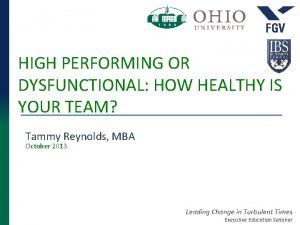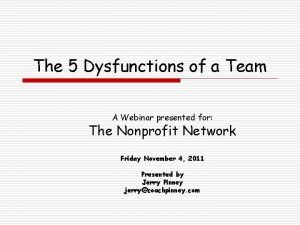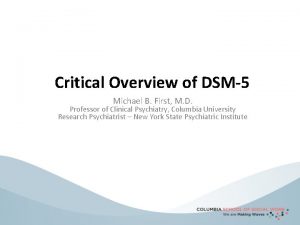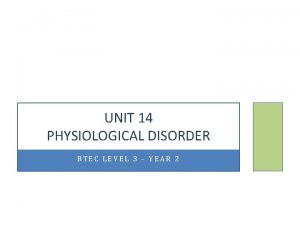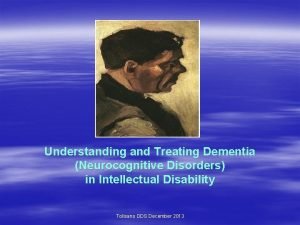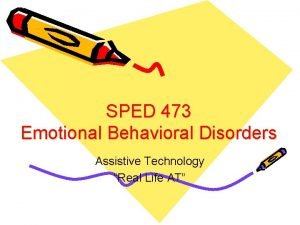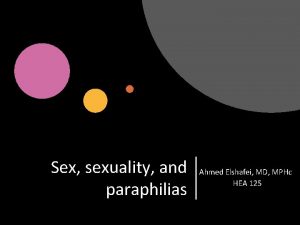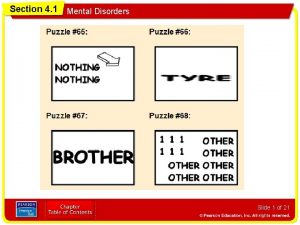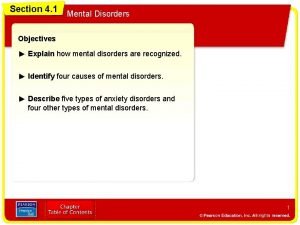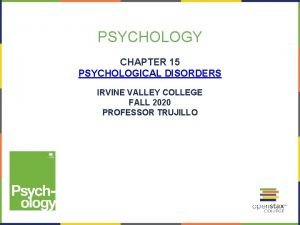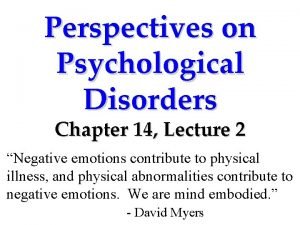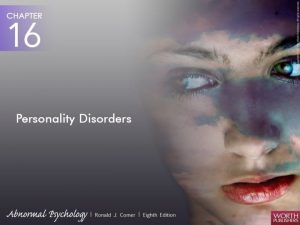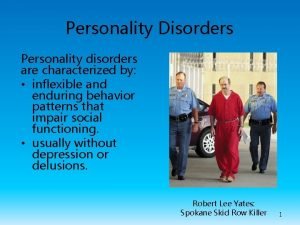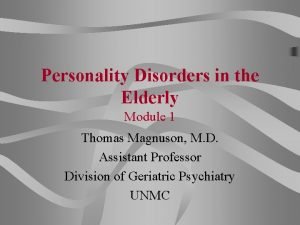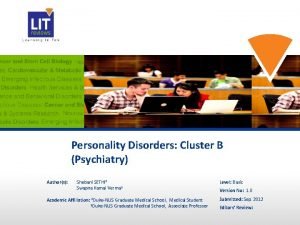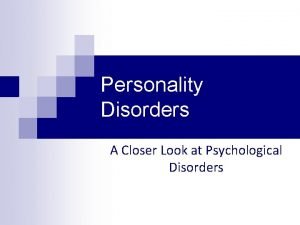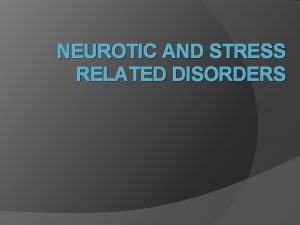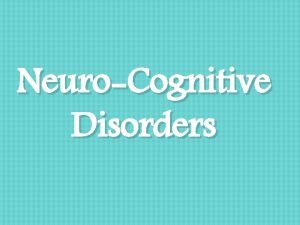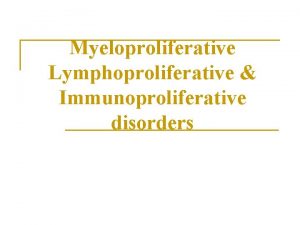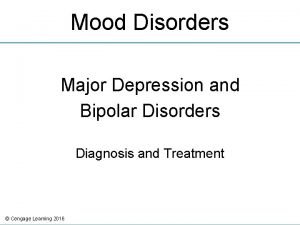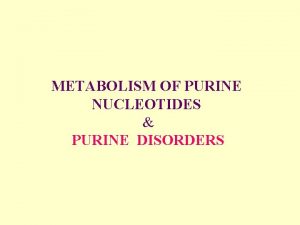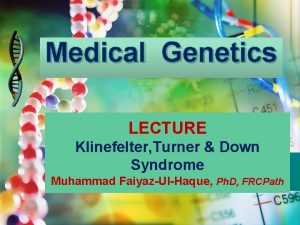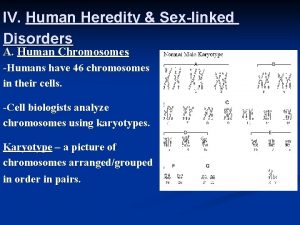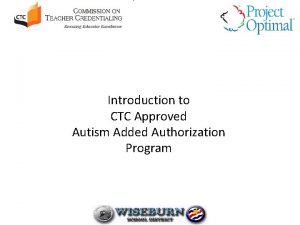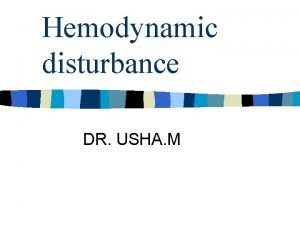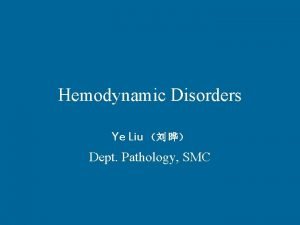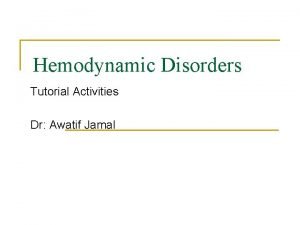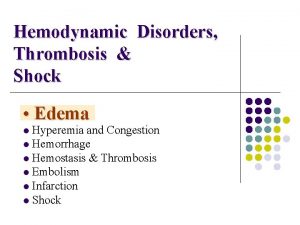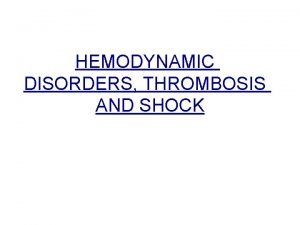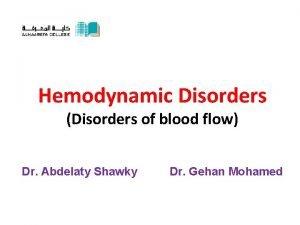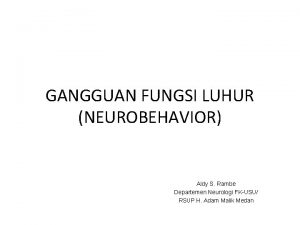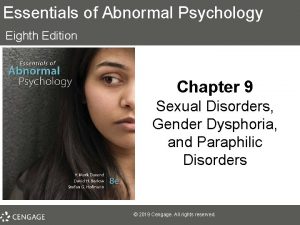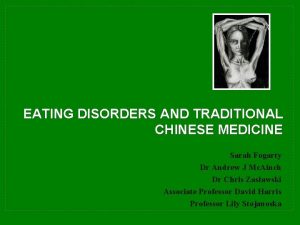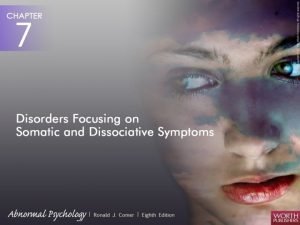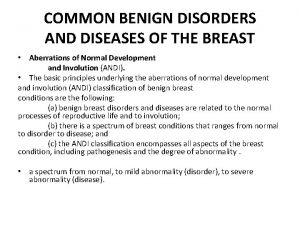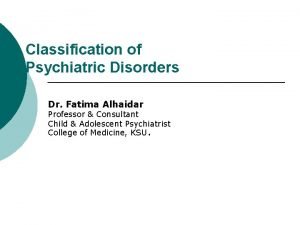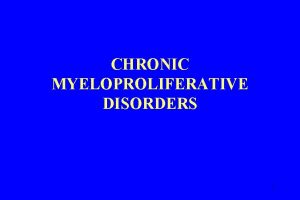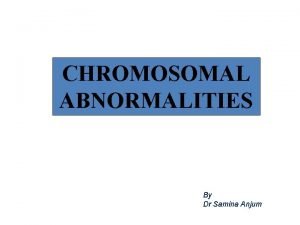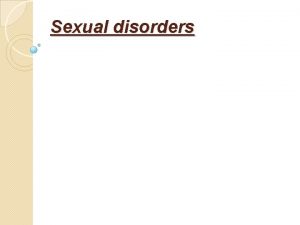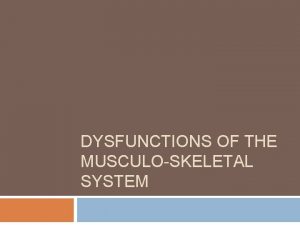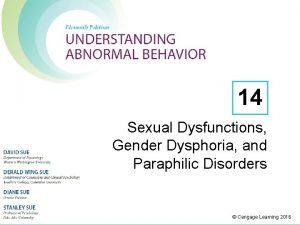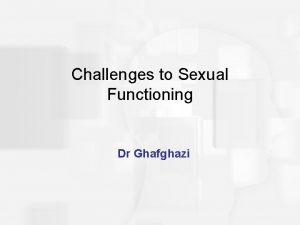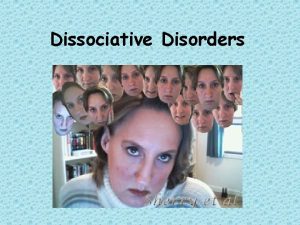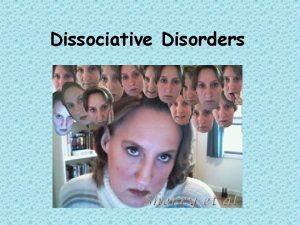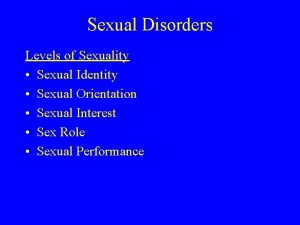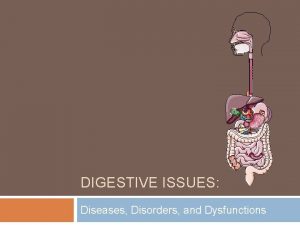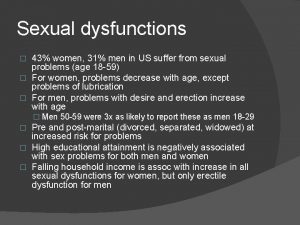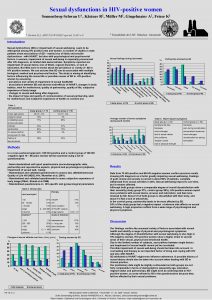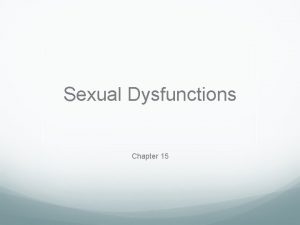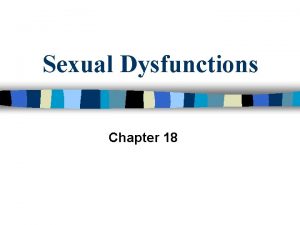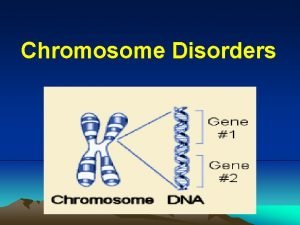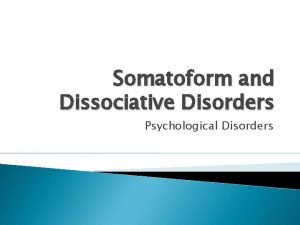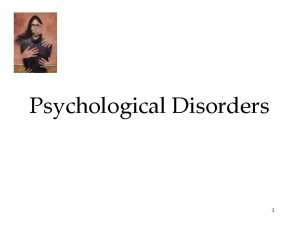Sexual Dysfunctions Sexual dysfunctions are disorders in which



























































- Slides: 59


Sexual Dysfunctions Sexual dysfunctions are disorders in which people cannot respond normally in key areas of sexual functioning o o As many as 31% of men and 43% of women in the U. S. suffer from such a dysfunction during their lives Sexual dysfunctions are typically very distressing, and often lead to sexual frustration, guilt, loss of self-esteem, and interpersonal problems o Often these dysfunctions are interrelated; many patients with one dysfunction experience another as well Copyright © 2015 by Worth Publishers. All rights reserved o

Sexual Dysfunctions The human sexual response can be described as a cycle with four phases: o o o Desire Excitement Orgasm Resolution Disorder of sexual desires affect one or more of the first three phases Copyright © 2015 by Worth Publishers. All rights reserved o

Copyright © 2015 by Worth Publishers. All rights reserved The Normal Sexual Response Cycle - Male

Copyright © 2015 by Worth Publishers. All rights reserved The Normal Sexual Response Cycle - Female

Disorders of Desire phase of the sexual response cycle o Consists of an urge to have sex, sexual fantasies, and sexual attraction to others Two dysfunctions affect this phase: • Male hypoactive sexual desire disorder • Female sexual interest/arousal disorder Copyright © 2015 by Worth Publishers. All rights reserved o

Hypoactive sexual desire disorder Female sexual interest/arousal disorder • Characterized by a lack of interest in sex and little sexual activity • Physical responses may be normal • Also lack normal interest in sex • Rarely initiate sexual activity • Many experience little excitement during sexual activity, are unaroused by erotic cues, and experience few genital or nongenital sensations during sexual activity Copyright © 2015 by Worth Publishers. All rights reserved Disorders of Desire

Copyright © 2015 by Worth Publishers. All rights reserved

o o A person's sex drive is determined by a combination of biological, psychological, and sociocultural factors, and any of these may reduce sexual desire Most cases of low sexual desire or sexual aversion are caused primarily by sociocultural and psychological factors, but biological conditions can also lower sex drive significantly Copyright © 2015 by Worth Publishers. All rights reserved Disorders of Desire

Disorders of Desire • A number of hormones interact to produce sexual desire and behavior • Abnormalities in their activity can lower sex drive • These hormones include prolactin, testosterone, and estrogen for both men and women • Recent investigation has also linked sexual desire disorders to excessive activity of the NTs serotonin and dopamine • Sex drive can also be lowered by some medications (including birth control pills and pain medications), some psychotropic drugs, a number of illegal drugs, and chronic illness Copyright © 2015 by Worth Publishers. All rights reserved Biological causes

Disorders of Desire • A general increase in anxiety, depression, or anger may reduce sexual desire in both men and women • Fears, attitudes, and memories may contribute to disorder of sexual desire • Certain psychological disorders, including depression and obsessive-compulsive disorder, may lead to sexual desire disorders Copyright © 2015 by Worth Publishers. All rights reserved Psychological causes

Disorders of Desire • Attitudes, fears, and psychological disorders that contribute to sexual desire disorders occur within a social context • Many sufferers of desire disorders are feeling situational pressures • Examples: divorce, death, job stress, infertility, and/or relationship difficulties • Cultural standards can set the stage for development of these disorders • The trauma of sexual molestation or assault is especially likely to produce disorder of sexual desire Copyright © 2015 by Worth Publishers. All rights reserved Sociocultural causes

Disorders of Excitement phase of the sexual response cycle o Marked by changes in the pelvic region, general physical arousal, and increases in heart rate, muscle tension, blood pressure, and rate of breathing o o o In men: erection of the penis In women: swelling of the clitoris and labia and vaginal lubrication Two dysfunctions affect this phase: o o Female sexual arousal disorder (formerly “frigidity”) Male erectile disorder (formerly “impotence”) Copyright © 2015 by Worth Publishers. All rights reserved o

Disorders of Excitement Male erectile disorder (ED) o o o Characterized by persistent inability to attain or maintain an adequate erection during sexual activity This problem occurs in as much as 10% of the general male population According to surveys, half of all adult men have erectile difficulty during intercourse at least some of the time Copyright © 2015 by Worth Publishers. All rights reserved o

Disorders of Excitement • The same hormonal imbalances that can cause hypoactive sexual desire can also produce ED • Most commonly, vascular problems are involved • The use of certain medications and substances may interfere with erections • Medical procedures have been developed for diagnosing biological causes of ED • One strategy involves measuring nocturnal penile tumescence (NPT) • Men typically have erections during REM sleep; abnormal or absent nighttime erections usually indicate a physical basis for erectile failure Copyright © 2015 by Worth Publishers. All rights reserved Biological causes

Disorders of Excitement • Any of the psychological causes of hypoactive sexual desire can also interfere with arousal and lead to erectile dysfunction • For example, as many as 90% of men with severe depression experience some degree of ED • One well-supported cognitive explanation for ED emphasizes performance anxiety and the spectator role • Once a man begins to have erectile difficulties, he becomes fearful and worries during sexual encounters; instead of being a participant, he becomes a spectator and judge • This can create a vicious cycle of disorder of sexual desire where the original cause of the erectile failure becomes less important than the fear of failure Copyright © 2015 by Worth Publishers. All rights reserved Psychological causes

Disorders of Excitement • Each of the sociocultural factors tied to hypoactive sexual desire has also been linked to ED • Job and marital distress are particularly relevant Copyright © 2015 by Worth Publishers. All rights reserved Sociocultural causes

Copyright © 2015 by Worth Publishers. All rights reserved

Disorders of Orgasm phase of the sexual response cycle o Sexual pleasure peaks and sexual tension is released as the muscles in the pelvic region contract rhythmically o o o For men: semen is ejaculated For women: the outer third of the vaginal walls contract There are three disorders of this phase: o o o Early ejaculation Delayed ejaculation Female orgasmic disorder Copyright © 2015 by Worth Publishers. All rights reserved o

Disorders of Orgasm – Early Ejaculation Characterized by persistent reaching of orgasm and ejaculation with little sexual stimulation o o As many as 30% of men experience rapid ejaculation at some time Psychological, particularly behavioral, explanations of this disorder have received more research support than other explanations o o The dysfunction seems to be typical of young, sexually inexperienced men It may also be related to anxiety, hurried masturbation experiences, or poor recognition of arousal Copyright © 2015 by Worth Publishers. All rights reserved o

Disorders of Orgasm – Delayed Ejaculation Characterized by a repeated inability to reach orgasm or by a very delayed orgasm after normal sexual excitement o o o Occurs in 8% of the male population Biological causes include low testosterone, neurological disease, and head or spinal cord injury A leading psychological cause appears to be performance anxiety and the spectator role, the cognitive factors involved in ED Copyright © 2015 by Worth Publishers. All rights reserved o

o o o Characterized by persistent delay in or absence of orgasm Most clinicians agree that orgasm during intercourse is not mandatory for normal sexual functioning Typically linked to female sexual arousal disorder o o The two disorders tend to be studied and treated together Once again, biological, psychological, and sociocultural factors may combine to produce these disorders Copyright © 2015 by Worth Publishers. All rights reserved Disorders of Orgasm- Female Orgasmic Disorder

Disorders of Orgasm- Female Orgasmic Disorder • A variety of physiological conditions can affect a woman's arousal and orgasm • The same medications and illegal substances that affect erection in men can affect arousal and orgasm in women • Postmenopausal changes may also be responsible Psychological causes • The psychological causes of hypoactive sexual desire and sexual aversion, including depression, may also lead to female arousal and orgasmic disorders • Memories of childhood trauma and relationship distress may also be related Copyright © 2015 by Worth Publishers. All rights reserved Biological causes

Disorders of Orgasm- Female Orgasmic Disorder • For years, the leading sociocultural theory of female disorder of sexual desire was that it resulted from sexually restrictive cultural messages • This theory has been challenged because: • Sexually restrictive histories are equally common in women with and without disorders • Cultural messages about female sexuality have been changing while the rate of female disorder of sexual desire stays constant • Researchers suggest that unusually stressful events, traumas, or relationships may produce the fears, memories, and attitudes that characterize these dysfunctions • Research has also linked orgasmic behavior to certain qualities in a woman's intimate relationships (such as emotional intimacy) Copyright © 2015 by Worth Publishers. All rights reserved Sociocultural causes

Genito-pelvic Pain/Penetration Disorder Dysfunctions that do not fit neatly into a specific phase of the sexual response cycle and are characterized by enormous physical discomfort during intercourse, and are called genito-pelvic pain/penetration disorders o o Vaginismus Dyspareunia Copyright © 2015 by Worth Publishers. All rights reserved o

Disorders of Sexual Pain Vaginismus o o o Characterized by involuntary contractions of the muscles of the outer third of the vagina This problem has received relatively little research, but estimates are that it occurs in fewer than 1% of all women Most clinicians agree with the cognitive-behavioral theory that vaginismus is a learned fear response Some women experience painful intercourse because of infection or disease Many women with vaginismus also have other sexual disorders Copyright © 2015 by Worth Publishers. All rights reserved o

Disorders of Sexual Pain Dyspareunia o Characterized by severe pain in the genitals during sexual activity o o o As many as 14% of women and about 3% of men suffer from this problem Dyspareunia in women usually has a physical cause, most commonly from injury sustained in childbirth Although psychological factors or relationship problems may contribute to dyspareunia, psychosocial factors alone are rarely responsible Copyright © 2015 by Worth Publishers. All rights reserved o

Treatments for Sexual Dysfunctions The last 40 years have brought major changes in the treatment of disorder of sexual desire o Early 20 th century: psychodynamic therapy o o Believed that disorder of sexual desire was caused by a failure to progress through the stages of psychosexual development Therapy focused on gaining insight and making broad personality changes; was generally unhelpful 1950 s and 1960 s: behavioral therapy 1970: Human Sexual Inadequacy Copyright © 2015 by Worth Publishers. All rights reserved o

What Are the General Features of Sex Therapy? Modern sex therapy is short-term and instructive o o Therapy typically lasts 15 to 20 sessions It is centered on specific sexual problems rather than on broad personality issues Copyright © 2015 by Worth Publishers. All rights reserved o

What Are the General Features of Sex Therapy? Modern sex therapy focuses on: Assessment and conceptualization of the problem Mutual responsibility Education about sexuality Emotion identification Attitude change Elimination of performance anxiety and the spectator role Increasing sexual and general communication skills Changing destructive lifestyles and marital interactions Addressing physical and medical factors Copyright © 2015 by Worth Publishers. All rights reserved o

What Techniques Are Applied to Particular Dysfunctions? Disorders of Desire o o These disorders are among the most difficult to treat because of the many issues that feed into them Therapists typically apply a combination of techniques, which may include: o Affectual awareness, self-instruction training, behavioral techniques, insight-oriented exercises, and biological interventions such as hormone treatments Copyright © 2015 by Worth Publishers. All rights reserved o

What Techniques Are Applied to Particular Dysfunctions? Erectile disorder o Treatments for ED focus on reducing a man's performance anxiety and/or increasing his stimulation o o May include sensate-focus exercises such as the “tease technique” Biological approaches have gained great momentum with the development of sildenafil (Viagra) and other erectile dysfunction drugs Copyright © 2015 by Worth Publishers. All rights reserved o

What Techniques Are Applied to Particular Dysfunctions? Male orgasmic disorder o o Like treatment for ED, therapies for this disorder include techniques to reduce performance anxiety and increase stimulation When the cause of the disorder is physical, treatment may include a drug to increase arousal of the sympathetic nervous system Copyright © 2015 by Worth Publishers. All rights reserved o

What Techniques Are Applied to Particular Dysfunctions? Early ejaculation o o Premature ejaculation has been successfully treated for years by behavioral procedures such as the “stop-start” or “pause” procedure Some clinicians use SSRIs, the serotonin-enhancing antidepressant drugs o o Because these drugs often reduce sexual arousal or orgasm, they may be helpful in delaying premature ejaculation Many studies have reported positive results with this approach Copyright © 2015 by Worth Publishers. All rights reserved o

What Techniques Are Applied to Particular Dysfunctions? Delayed ejaculation o o Therapies for delayed ejaculation include techniques to reduce performance anxiety and increase stimulation When delayed ejaculation is caused by physical factors such as neurological damage or injury, treatment may include a drug to increase arousal of the sympathetic nervous system Copyright © 2015 by Worth Publishers. All rights reserved o

What Techniques Are Applied to Particular Dysfunctions? Female orgasmic disorder o Specific treatments for these disorders include cognitive -behavioral techniques, self-exploration, enhancement of body awareness, and directed masturbation training o Biological treatments, including hormone therapy or the use of sildenafil (Viagra), have also been tried, but research has not found such interventions to be consistently helpful Copyright © 2015 by Worth Publishers. All rights reserved o

What Techniques Are Applied to Particular Dysfunctions? Vaginismus o Specific treatment for vaginismus typically involves two approaches: o o o Practice tightening and releasing the muscles of the vagina to gain more voluntary control Overcome fear of penetration through gradual behavioral exposure treatment Dyspareunia o Determining the specific cause of dyspareunia is the first stage of treatment o Given that most cases are caused by physical problems, medical intervention may be necessary Copyright © 2015 by Worth Publishers. All rights reserved o

What Are the Current Trends in Sex Therapy? Sex therapists have moved well beyond the approach first developed by Masters and Johnson o Therapists now treat unmarried couples, those with other psychological disorders, couples with severe marital discord, the elderly, the medically ill, the physically handicapped, gay clients, and clients with no long-term sex partner Copyright © 2015 by Worth Publishers. All rights reserved o

What Are the Current Trends in Sex Therapy? o Therapists are paying more attention to excessive sexuality, which is sometimes called hypersexuality or sexual addiction The use of medications to treat disorder of sexual desire is troubling to many therapists o They are concerned that therapists will choose biological interventions rather than a more integrated approach Copyright © 2015 by Worth Publishers. All rights reserved o

Paraphilias These disorders are characterized by intense sexual urges, fantasies or behaviors that involve: o o Nonhumans Children Nonconsenting adults The experience of suffering or humiliation Copyright © 2015 by Worth Publishers. All rights reserved o

Paraphilias According to the DSM-5, paraphilias should be diagnosed only when the urges, fantasies, or behaviors last at least 6 months o o For most paraphilias, the urges, fantasies, or behaviors must also cause great distress or interfere with one's functioning Some people with one kind of paraphilia display others as well o Relatively few people receive a formal diagnosis, but clinicians suspect that the patterns may be quite common Copyright © 2015 by Worth Publishers. All rights reserved o

Copyright © 2015 by Worth Publishers. All rights reserved

Paraphilias Although theorists have proposed various explanations for paraphilias, there is little formal evidence to support them o o None of the treatments applied to paraphilias have received much research or been proved clearly effective Psychological and sociocultural treatments have been available the longest, but today's professionals are also using biological interventions Copyright © 2015 by Worth Publishers. All rights reserved o

Fetishistic Disorder The key features of fetishistic disorder are recurrent intense sexual urges, sexually arousing fantasies, or behaviors that involve the use of a nonliving object, often to the exclusion of all other stimuli o o o The disorder, far more common in men than women, usually begins in adolescence Almost anything can be a fetish Researchers have been unable to pinpoint the causes of fetishistic disorder o Psychodynamic theorists view fetishes as defense mechanisms, but therapy using this model has been unsuccessful Copyright © 2015 by Worth Publishers. All rights reserved o

Fetishistic Disorder Behaviorists propose that fetishes are learned through classical conditioning o o o Fetishes are sometimes treated with aversion therapy, or covert sensitization Another behavioral treatment is masturbatory satiation, in which clients masturbate to boredom while imagining the fetish object An additional behavioral treatment is orgasmic reorientation, a process which teaches individuals to respond to more appropriate sources of sexual stimulation Copyright © 2015 by Worth Publishers. All rights reserved o

o o o Also known as transvestism or cross-dressing Characterized by fantasies, urges, or behaviors involving dressing in the clothes of the opposite sex in order to achieve sexual arousal The typical person with transvestism is a heterosexual male who began cross-dressing in childhood or adolescence Transvestism is often confused with gender dysphoria (transsexualism), but the two are separate patterns The development of the disorder seems to follow the behavioral principles of operant conditioning Copyright © 2015 by Worth Publishers. All rights reserved Transvestic Disorder

Exhibitionistic Disorder Characterized by arousal from the exposure of genitals in a public setting o o Also known as “flashing” Sexual contact is rarely initiated nor desired Usually begins before age 18 and is most common in males Treatment generally includes aversion therapy and masturbatory satiation o May be combined with orgasmic reorientation, social skills training, or cognitive-behavioral therapy Copyright © 2015 by Worth Publishers. All rights reserved o

Voyeuristic Disorder Characterized by repeated and intense sexual urges to observe people as they undress or to spy on couples having intercourse o o The person may masturbate during the act of observing or while remembering it later The risk of discovery often adds to the excitement Many psychodynamic theorists propose that voyeurs are seeking power Behaviorists explain voyeurism as a learned behavior that can be traced to a chance and secret observation of a sexually arousing scene Copyright © 2015 by Worth Publishers. All rights reserved o

Frotteuristic Disorder A person who develops frotteuristic disorder has recurrent and intense fantasies, urges, or behaviors involving touching and rubbing against a nonconsenting person o o Almost always male, the person fantasizes during the act that he is having a caring relationship with the victim Usually begins in the teen years or earlier o Acts generally decrease and disappear after age 25 Copyright © 2015 by Worth Publishers. All rights reserved o

Pedophilic Disorder Characterized by fantasies, urges, or behaviors involving sexual activity with a prepubescent child, usually 13 years of age or younger o o o Some people are satisfied with child pornography Others are driven to watching, fondling, or engaging in sexual intercourse with children Evidence suggests that two-thirds of victims are female Copyright © 2015 by Worth Publishers. All rights reserved o

Pedophilic Disorder People with pedophilic disorder develop the disorder in adolescence o o o Some were sexually abused as children Most are immature, display distorted thinking, and have an additional psychological disorder Most people with pedophilic disorder are imprisoned or forced into treatment o o Treatments include aversion therapy, masturbatory satiation, orgasmic reorientation, and treatment with antiandrogen drugs Cognitive-behavioral treatment involves relapse-prevention training, modeled after programs used for substance dependence Copyright © 2015 by Worth Publishers. All rights reserved o

o o Characterized by fantasies, urges, or behaviors involving the act or the thought of being humiliated, beaten, bound, or otherwise made to suffer Most masochistic fantasies begin in childhood and seem to develop through the behavioral process of classical conditioning Copyright © 2015 by Worth Publishers. All rights reserved Sexual Masochism Disorder

Sexual Sadism Disorder A person with sexual sadism finds fantasies, urges, or behaviors involving the thought or act of psychological or physical suffering of a victim sexually exciting o o Named for the infamous Marquis de Sade People with sexual sadism imagine that they have total control over a sexual victim Copyright © 2015 by Worth Publishers. All rights reserved o

Sexual Sadism Sadistic fantasies may first appear in childhood or adolescence o o o Pattern is long-term Appears to be related to classical conditioning and/or modeling Psychodynamic and cognitive theorists view people with sexual sadism as having underlying feelings of sexual inadequacy Biological studies have found signs of possible brain and hormonal abnormalities The primary treatment for this disorder is aversion therapy Copyright © 2015 by Worth Publishers. All rights reserved o

The definitions of paraphilic disorders, like those of sexual dysfunctions, are strongly influenced by the norms of the particular society in which they occur Some clinicians argue that, except when people are hurt by them, many paraphilic behaviors should not be considered disorders at all Copyright © 2015 by Worth Publishers. All rights reserved A Word of Caution

o o According to current DSM-5 criteria, people with this disorder persistently feel that they have been assigned to the wrong biological sex, and gender changes would be desirable The DSM-5 categorization of this disorder has become controversial in recent years o o Many people believe that transgender experiences reflect alternative – not pathological – ways of experiencing one's gender identity Others argue that gender dysphoria is, in fact, a medical problem that may produce personal unhappiness Copyright © 2015 by Worth Publishers. All rights reserved Gender Dysphoria

Copyright © 2015 by Worth Publishers. All rights reserved

Gender Dysphoria The disorder sometimes emerges in childhood and disappears with adolescence o o In some cases it develops into adult gender dysphoria Many clinicians suspect biological – perhaps genetic or prenatal – factors o Abnormalities in the brain, including the hypothalamus (particularly the bed nucleus of stria terminalis), are a potential link Copyright © 2015 by Worth Publishers. All rights reserved o

Gender Dysphoria To more effectively assess and treat those with the disorder, clinical theorists have tried to distinguish the most common patterns of gender dysphoria: o o Female-to-male Male-to-female: Androphilic Type Male-to-female: Autogyneophilic Type Many adults with GD receive psychotherapy o Some adults with this disorder change their sexual characteristics by way of hormones; others opt for sexual reassignment (sex change) surgery Copyright © 2015 by Worth Publishers. All rights reserved o
 Antigentest åre
Antigentest åre 5 dysfunctions of a team powerpoint
5 dysfunctions of a team powerpoint 5 dysfunctions of a team questions
5 dysfunctions of a team questions Functions and dysfunctions of deviance
Functions and dysfunctions of deviance Dsm v sexual disorders
Dsm v sexual disorders Physiological disorders unit 14
Physiological disorders unit 14 Unit 14 physiological disorders p1
Unit 14 physiological disorders p1 Neurocognitive disorders
Neurocognitive disorders Bipolar and other related disorders
Bipolar and other related disorders Bipolar and other related disorders
Bipolar and other related disorders Flinders model of care
Flinders model of care Assistive technology for emotional disturbance
Assistive technology for emotional disturbance Nursing diagnosis of somatoform disorder
Nursing diagnosis of somatoform disorder Paraphilia disorders
Paraphilia disorders Types of sensory disorders
Types of sensory disorders Section 4-1 mental disorders answers
Section 4-1 mental disorders answers Section 4-1 mental disorders answers
Section 4-1 mental disorders answers Puberty and autism spectrum disorders
Puberty and autism spectrum disorders Medical model psychology
Medical model psychology What are the 10 personality disorders
What are the 10 personality disorders Cluster b personality disorder
Cluster b personality disorder Axis 1 and axis 2 disorders
Axis 1 and axis 2 disorders Avoidant personality traits
Avoidant personality traits Personality disorders dsm 5
Personality disorders dsm 5 Group c personality disorders
Group c personality disorders Cluster c personality disorders symptoms
Cluster c personality disorders symptoms Cluster b personality disorder traits
Cluster b personality disorder traits Obsessive personality
Obsessive personality Yorkshire centre for eating disorders
Yorkshire centre for eating disorders Neurotic stress related and somatoform disorders
Neurotic stress related and somatoform disorders Mild neurocognitive disorder
Mild neurocognitive disorder Immunoproliferative disorders examples
Immunoproliferative disorders examples Mood disorders dsm 5
Mood disorders dsm 5 Orotic
Orotic Purine disorders
Purine disorders Monosomy disorders
Monosomy disorders Sex linked disorders
Sex linked disorders Unit 14 physiological disorders assignment 1
Unit 14 physiological disorders assignment 1 Autism authorization online program
Autism authorization online program Chorionic villus
Chorionic villus Hemodynamic disorders
Hemodynamic disorders Coagulation casecade
Coagulation casecade Hemodynamic disorders
Hemodynamic disorders Hemodynamic disorders
Hemodynamic disorders Robbins
Robbins Hemodynamic disorders
Hemodynamic disorders Neurobehavioral disorders list
Neurobehavioral disorders list Hemodynamic disorders
Hemodynamic disorders Causes of paraphilic disorders
Causes of paraphilic disorders Eating disorders in uae
Eating disorders in uae Sarah fogarty
Sarah fogarty Dissociative disorders
Dissociative disorders Attachment issues meaning
Attachment issues meaning Congenital voice disorders
Congenital voice disorders Andi in breast disease
Andi in breast disease Neurosis vs psychosis
Neurosis vs psychosis Karla homulka
Karla homulka Myeloproliferative disease
Myeloproliferative disease Chromosome abnormalities
Chromosome abnormalities Chapter 8 skin disorders and diseases review questions
Chapter 8 skin disorders and diseases review questions

